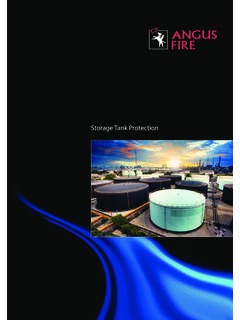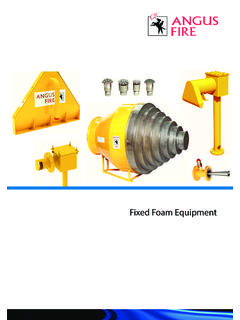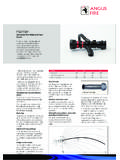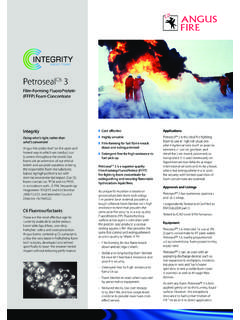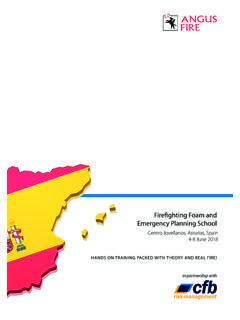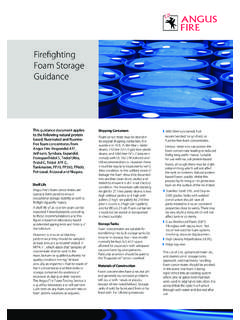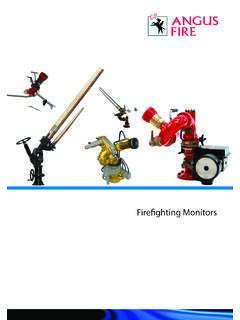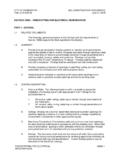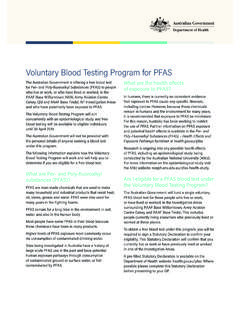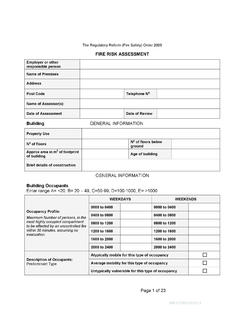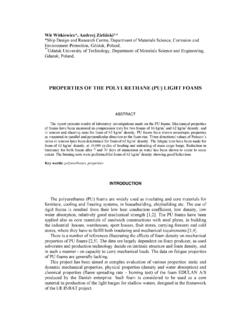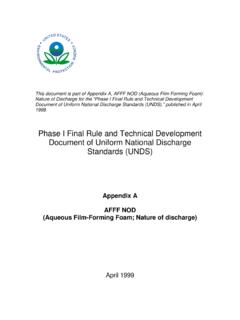Transcription of Storage Tank Protection - Angus Fire
1 Storage Tank ProtectionFire in a Storage tank, or in the surrounding bund, is a challenge to both fire fighters and tank operators. The value of the contents makes the provision of fire Protection commercially viable, while the risk to life makes it fire Protection options available to tank operators and designers are wider than ever before, and the selection of the right combination of equipment can mean the difference between safe operation and disaster. Many factors influence the decision making; the type/design of atmospheric Storage tanks , the layout and spacing of the tanks , the construction of the bund walls and the product stored in the the fire Protection perspective EN13565 Part 2 Section and in the US, the NFPA (National fire Protection Association) publish guidelines for tank fire Protection .
2 These classify the product stored by fire hazard and specify the foam delivery rates, layout, and spacing of foam delivery systems. Foam application rates depend on the tank contents, and start at 4 litres/m2/min typically and could rise as high as 12 litres/m2/min for foam destructive products such as Polar Solvents, where fixed foam systems are fire manufactures a wide range of fire Protection products and systems, which meet international safety guidelines for the Storage of petroleum products in terminals, refineries and petrochemical installations. In selecting the correct equipment to protect your specific risks, Angus fire can support you with technical expertise from our in-house engineering and design ConcentratesFirefighting foam is an essential component of all tank Protection systems.
3 Angus fire manufactures a range of foam concentrates to suit differing application systems and tank content. These range from general purpose foams for hydrocarbon based risks preferably Fluoroprotein foams (FP) with their excellent heat resistant properties and slow drainage to specialised foams for polar solvent or other water miscible risks, such as Alcohol Resistant Aqueous Film Forming Foam (AR-AFFF) or AR-FFFP (Alcohol Resistant Film Forming Fluoroprotein). Foam InductionAt the heart of tank Protection is the choice of the foam induction proportioning system, or in other words, mixing the foam and water in the correct proportions.
4 The foam delivery device, such as a Top Pourer or a Rimseal Pourer, dictates the amount of foam solution required. For systems where the foam solution demand is constant, fixed inline inductors can be used. For systems with variable foam solution demand, two options are available, either balanced pressure foam proportioner(s) with a bag tank, or balanced pressure proportioner(s) with a balanced valve on a foam skid. Foam Skids can be powered by water, electric or diesel driven motor foam pumps. Single or multiple skids can be sized to feed all the foam system on the site. Thus foam skids (and water deluge skids) are bespoke items which are not readily available off the shelf.
5 ApprovalsThe engineering and design of foam skids and entire fire systems is a service provided by Angus fire Engineering (AFE). AFE s team of dedicated engineers are specialists in systems design for high value, high risk applications. They are familiar with the details of the international standards that are specified by most insurance companies and major international oil companies. However, the system design is no good if the equipment connected to it (top pourers, rim seal pourers etc.) does not perform to specification. To overcome this, many insurers and operators insist that the equipment is approved by an independent body.
6 Angus fire manufactures products certified by international organisations such as UL (Underwriters Laboratory) in the US, and in Europe test protocols such as LASTFIRE. UL is the most widely recognised approvals body that tests both the foam concentrate together with the delivery equipment that it will be used with, making it a true systems fire As a world leader in fire Protection , with a track record of over 220 years and operations in more than 100 countries around the world, Angus fire remains at the forefront of the design of cutting-edge fire equipment products that meet the most stringent standards and are approved by key industry approval bodies.
7 An important part of our range is equipment to protect fuel Storage Depots and Terminals. Angus fire manufactures both the equipment and the foam concentrate needed to protect these high risk assets. Almost uniquely amongst fire Protection companies, Angus fire has the ability to design and engineer the systems most commonly used for tank Protection . As a result we are well placed to guide our customers through the myriad of equipment available for these in the safest solutionAngus fire protecting Lives,the Environment andCritical AssetsFixed/cone roof tanks are used to store hydrocarbon or polar solvents fuels with vapour pressures close to atmospheric.
8 They are usually designed to have a weak seam between the shell and the roof to allow the roof to blow off in the event of a major catastrophe. Some fixed roof tanks feature an inert gas blanket to minimize the risk of fire in the vapour space. In fixed roof Storage tanks fires commonly start as a result of over filling the tank. Foam SystemFixed roof Storage tanks are protected using Top Pouring Systems designed to apply foam gently through the tank wall onto the burning surface of the fuel. Gentle application is preferred to maximise the efficiency of the finished foam. The Angus fire Top Pourer features a unique butterfly nozzle that is designed to throw the foam back onto the tank wall.
9 One of the most important requirements is that the selected Top Pourer can be easily accessed for maintenance and testing. The Angus fire Top Pourer features an easily accessible pivoting top cover to allow the system to be tested and samples taken, without discharging foam into the tank. For pressurised tanks Angus fire manufactures a specific range of Top Pourers to protect tanks that are pressurised in this way. Other fixed roof tanks have internal blankets to suppress the release of vapours and depending on the type of blanket the firefighting system can be designed in the same way as for a floating roof tank.
10 To protect fixed roof tanks for aviation depots base injection is often preferred. High Fixed Roof TankBack Pressure Generators are used to inject expanded foam through the bottom of the tank. As they are located at ground level base injection systems are easy to maintain. The Angus HBPG is able to operate against a back pressure of 45%. Water CoolingProvision should be made for the application of cooling water to fixed roof tanks , to minimise the effect of radiated heat. For the roof itself Angus offers a Mushroom Nozzle and the tank walls can be cooled with the Angus fire Tank Cool Nozzle.
